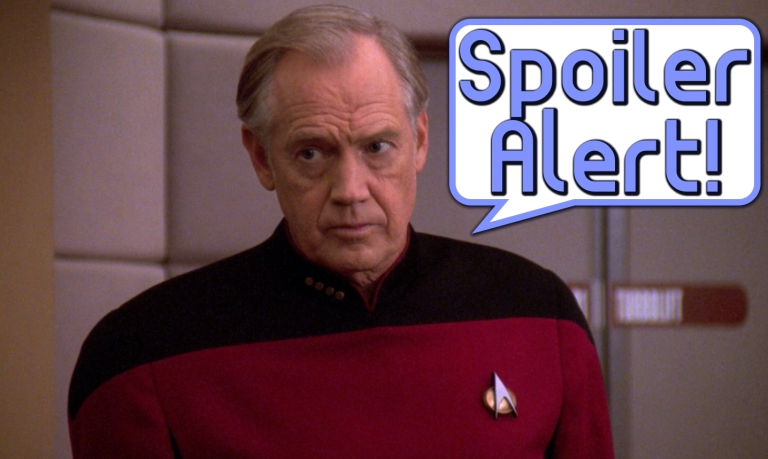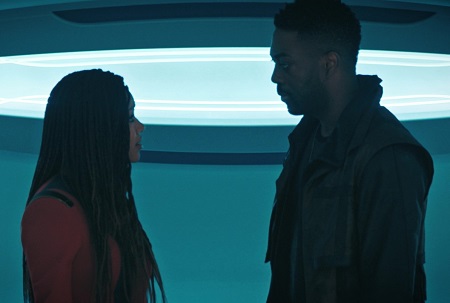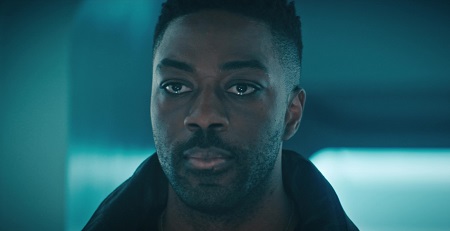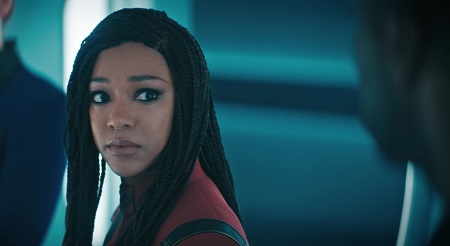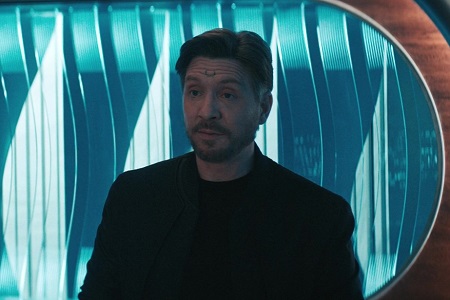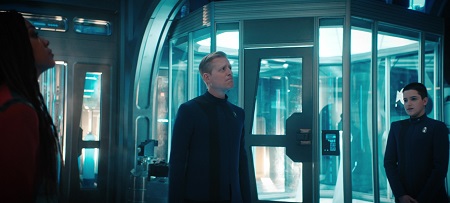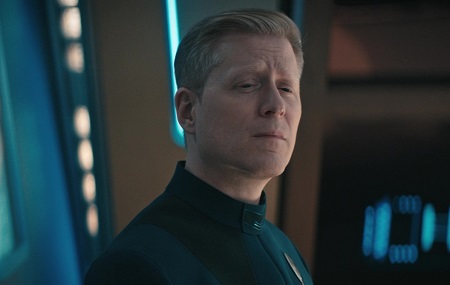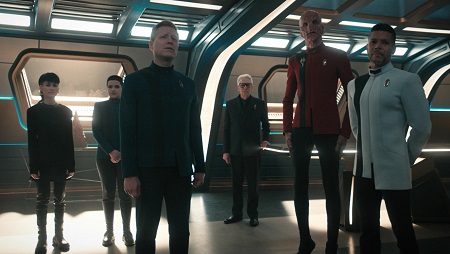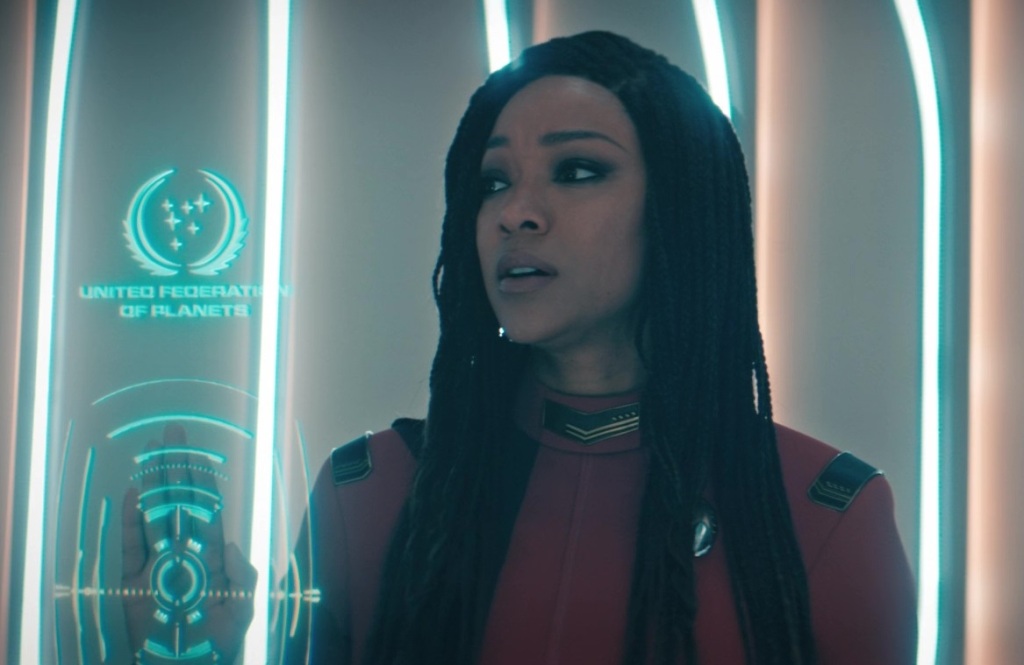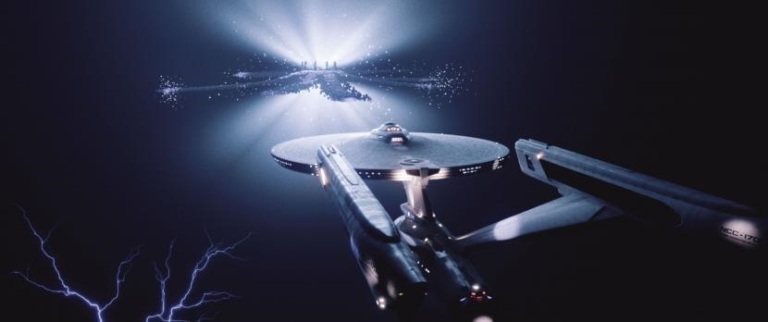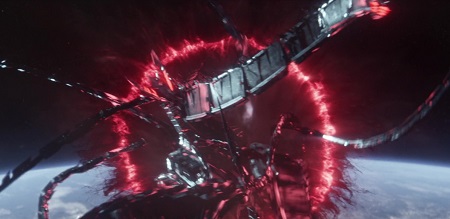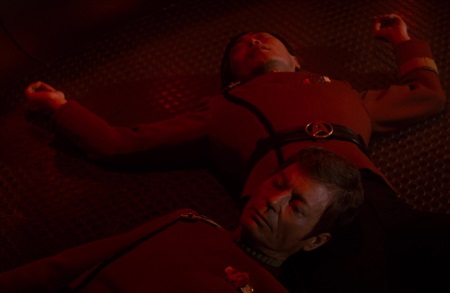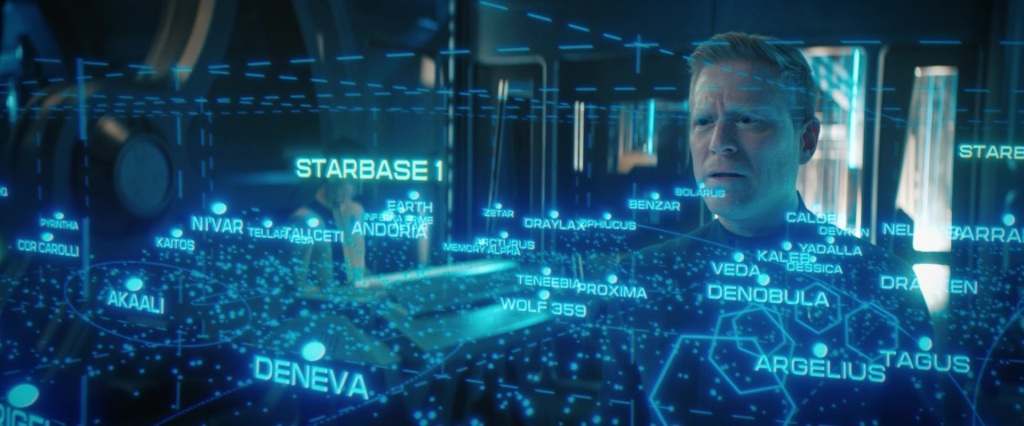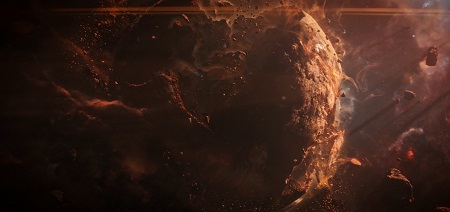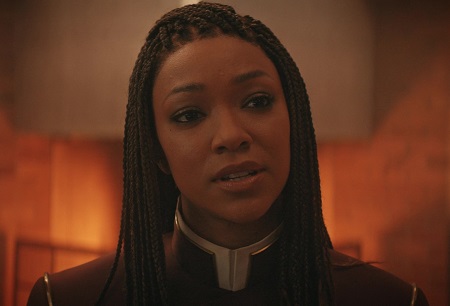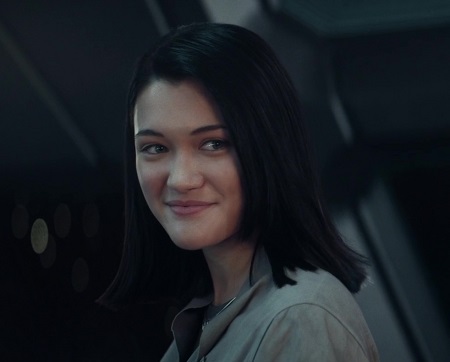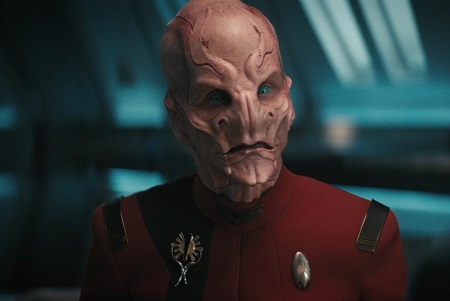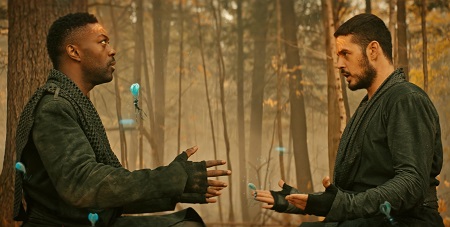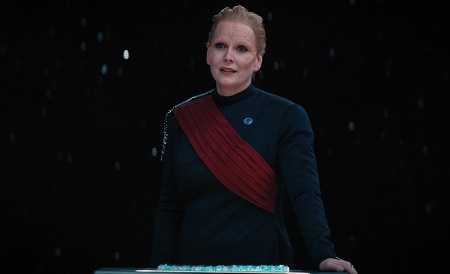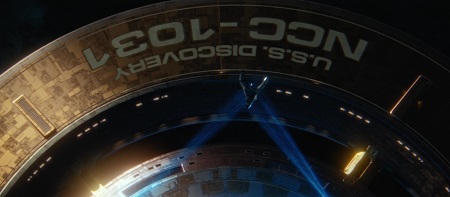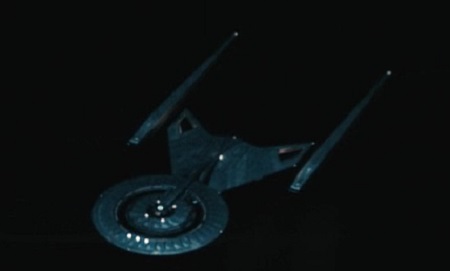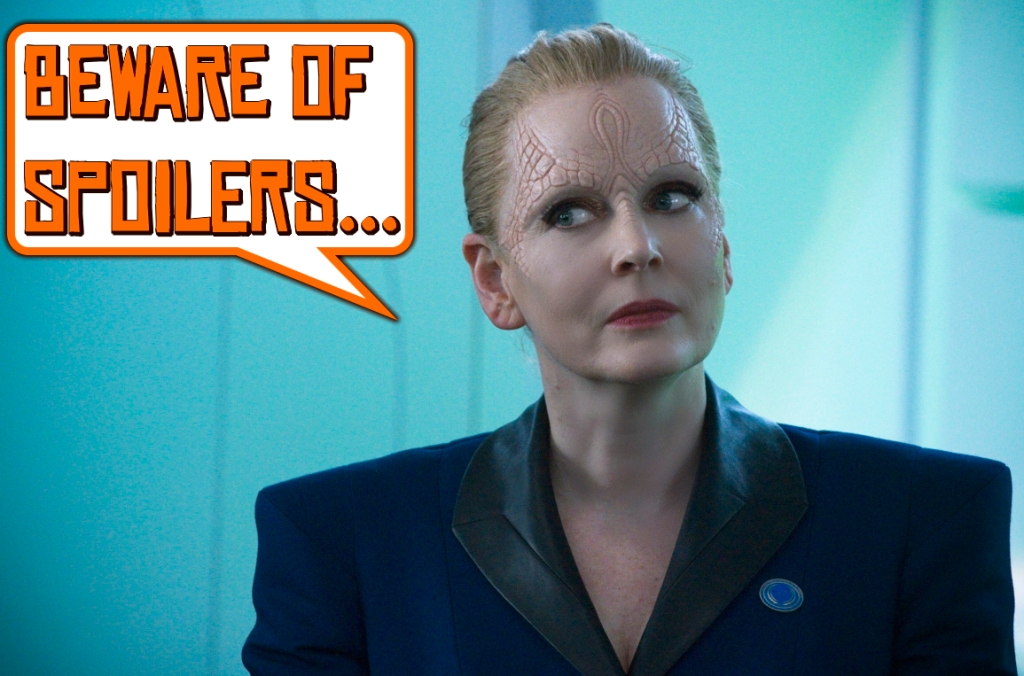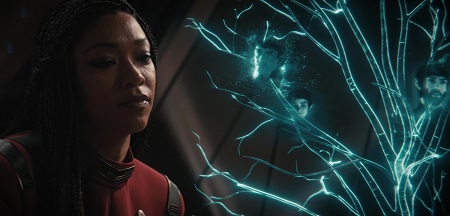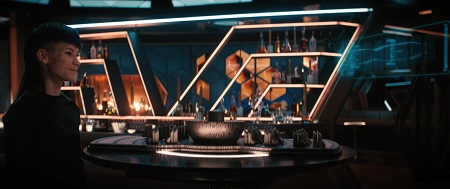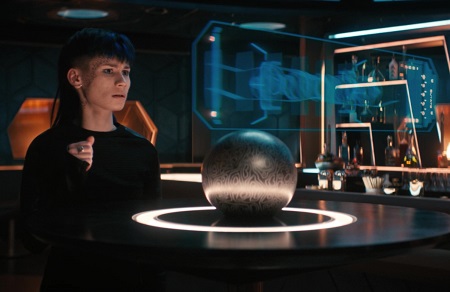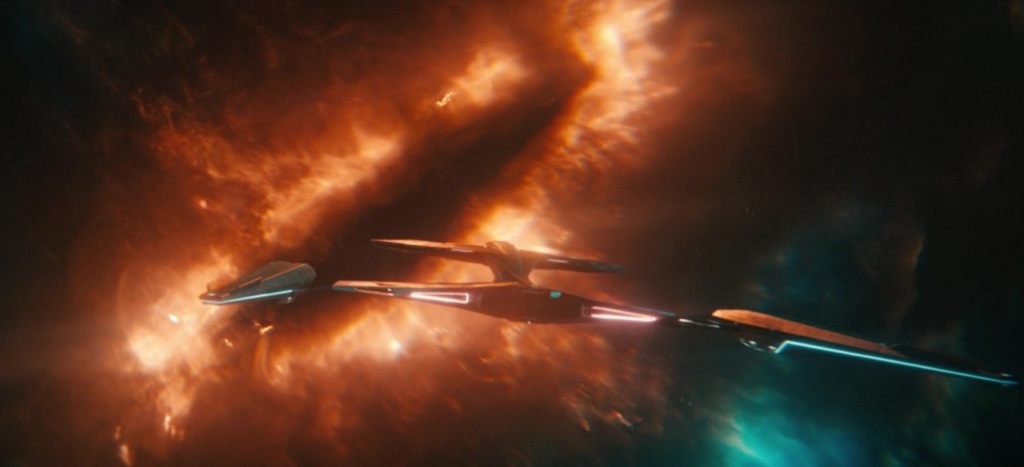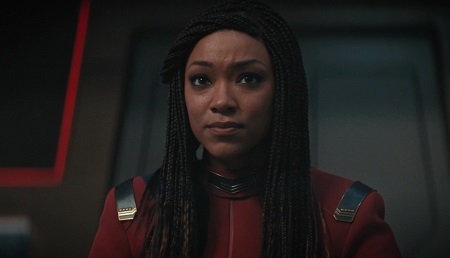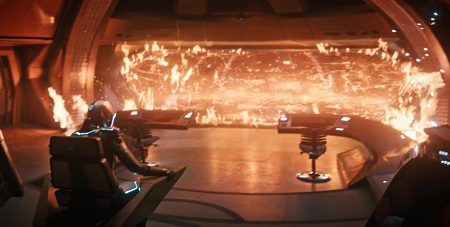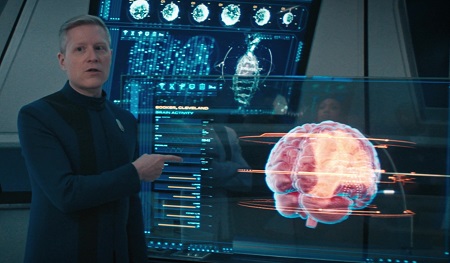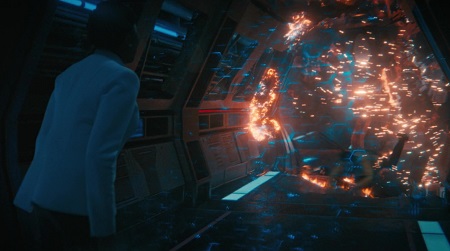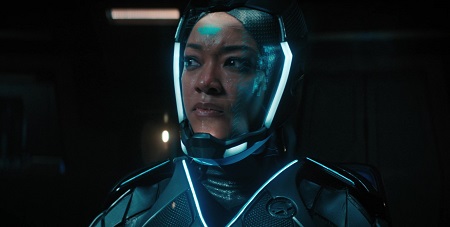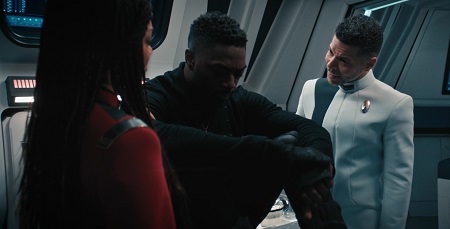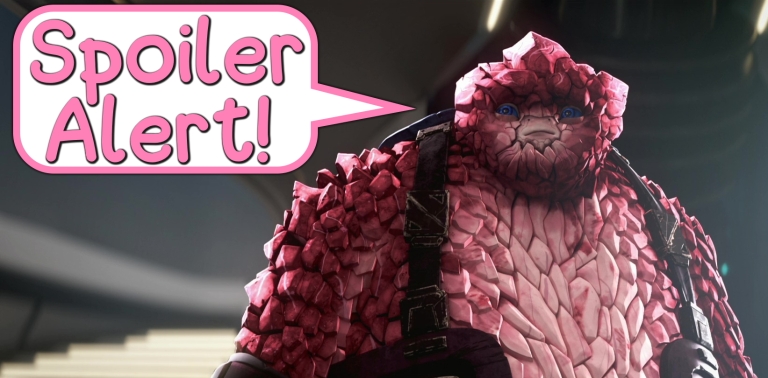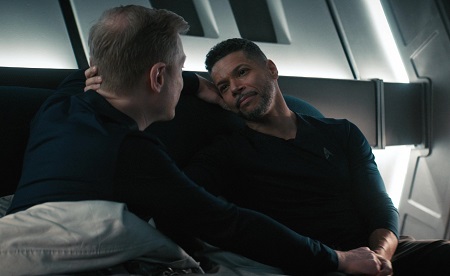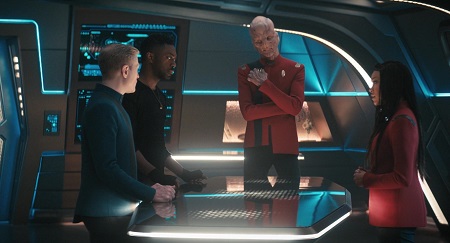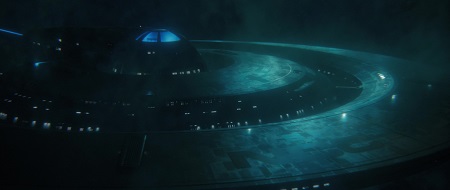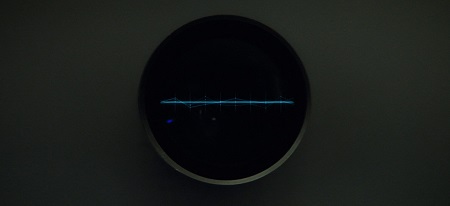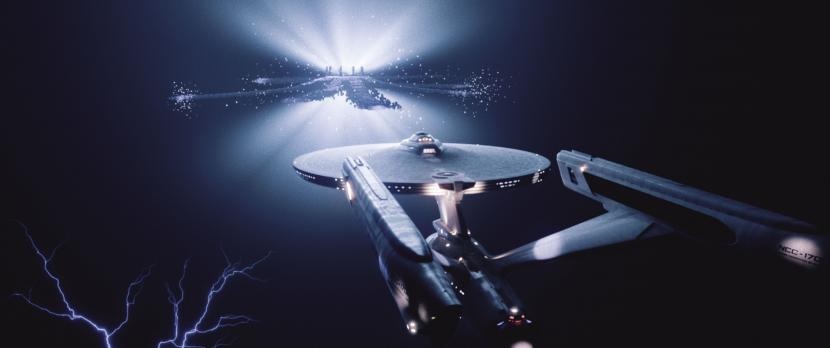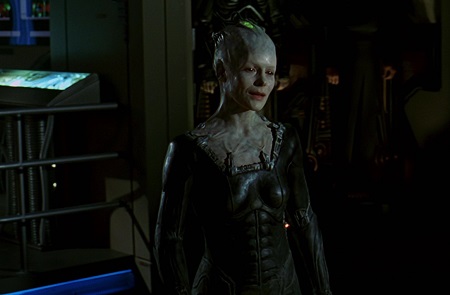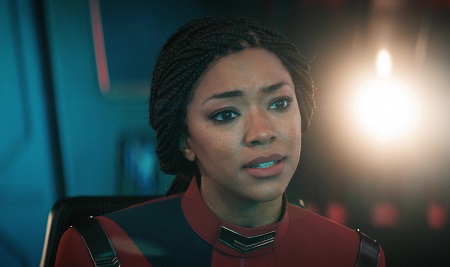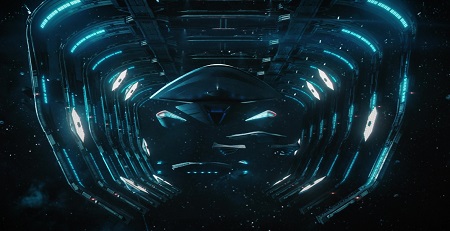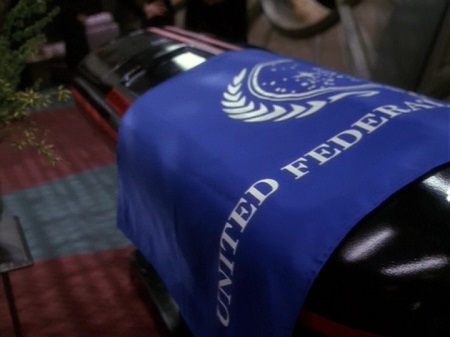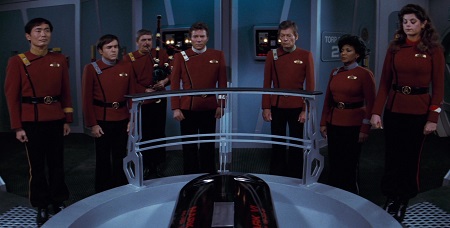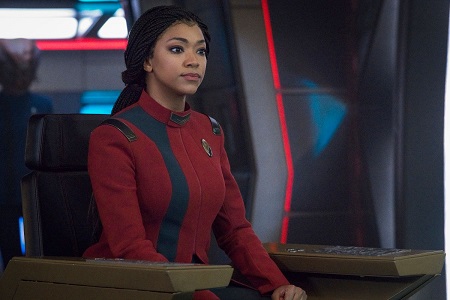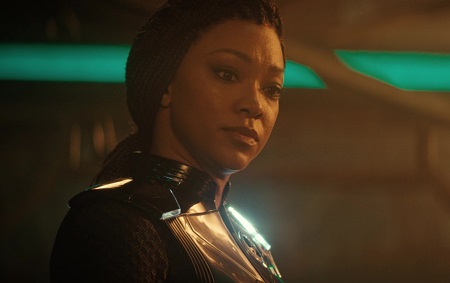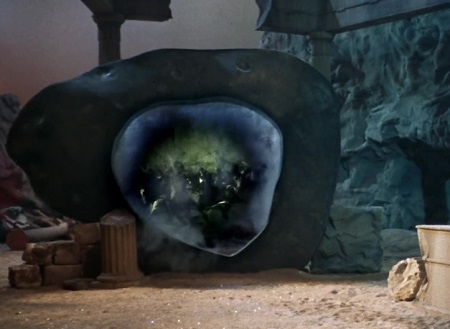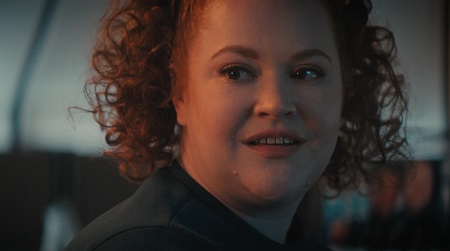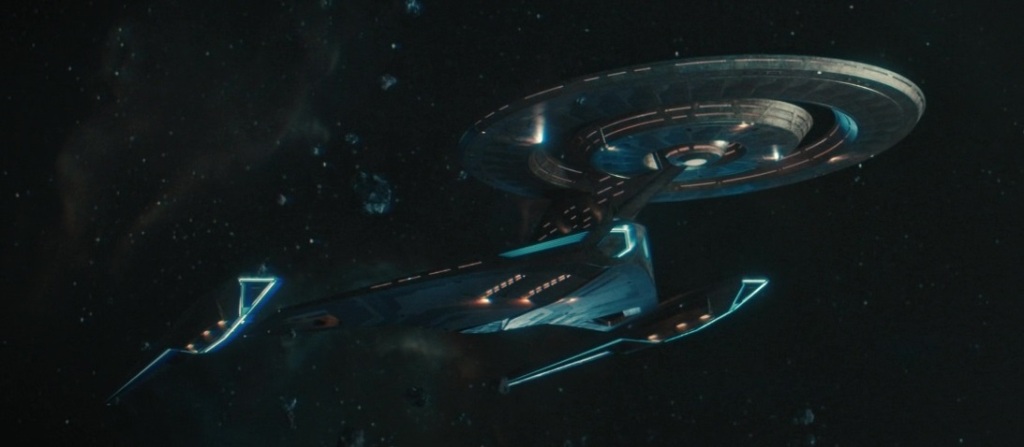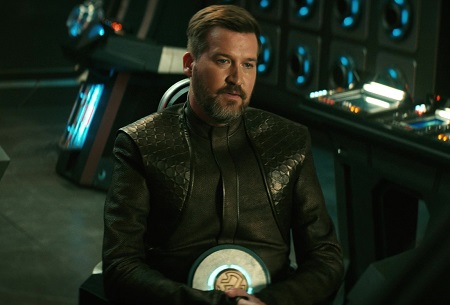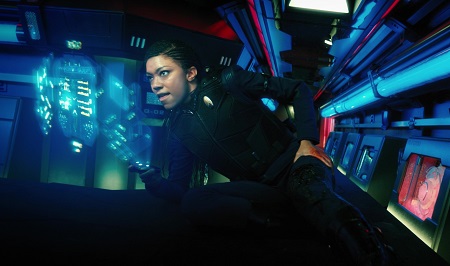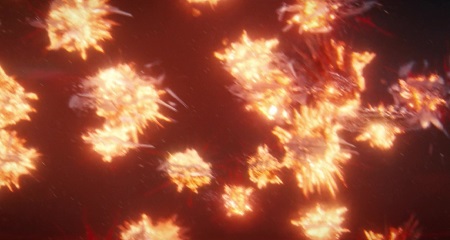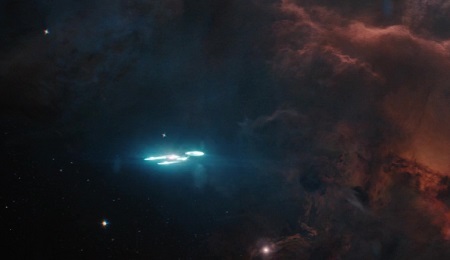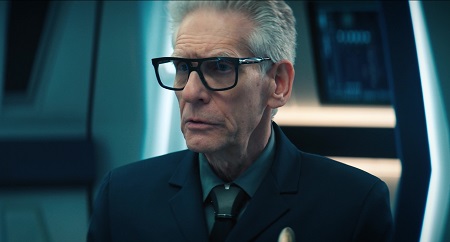
Spoiler Warning: There are spoilers ahead for Star Trek: Discovery Seasons 1-4, Short Treks, Star Trek: Picard Season 1, Star Trek: Lower Decks Season 1, and for other iterations of the Star Trek franchise.
Because Discovery is currently taking an unscheduled six-week break, I was in no rush to update my theory list! The second half of Season 4 won’t air until the 10th of February (or the 11th here in the UK), so there was more time than usual to consider the implications of the most recent episode: But To Connect.
But To Connect worked well as a mid-season finale, even though some of its story points weren’t my personal favourites and some of the drama felt rather contrived. We have some interesting questions to consider about Ruon Tarka in particular, as the Risian scientist told us some very interesting and unexpected things.
This week we have three retiring theories and one confirmation. As always, we’ll look at those first before we jump into the main list.
Retired theory #1:
Dr Kovich is an agent of Section 31.

Though Dr Kovich’s role within the hierarchy of Starfleet and the Federation is still unexplained, after But To Connect I think we can finally retire this theory – one which I’d been holding on to since we first met the character in Season 3.
Dr Kovich’s early interactions with Georgiou in particular seemed to show him as someone morally ambiguous to the point of being uncaring; he knew that Georgiou’s health was going to fail, yet did nothing to warn her or Captain Saru. Combined with his stoic demeanour and a sense that he wasn’t telling us anywhere close to everything he knew, I speculated that he could be an operative – or even the head – of shadowy organisation Section 31.

There was the potential for some kind of tie-in with the Section 31 series, but with that project seemingly being shelved (at least for now), that doesn’t seem like it’s a consideration for the writers and producers in charge of the overall direction of the Star Trek franchise. In fact, we haven’t seen any mention of Section 31 explicitly since Season 2.
We’ve seen Dr Kovich as a psychologist, working with Starfleet Intelligence, having a say in the running of Starfleet Academy, and now as an expert in the field of AI. Whoever he is, and whatever formal title or position he holds, I think we can finally rule out Section 31. Dr Kovich has turned out, to my surprise I must confess, to be one of the true believers in the goals and ideals of Starfleet – something he demonstrated clearly in But To Connect through his interactions with Zora and Stamets.
Retired theory #2:
Zora will go rogue.
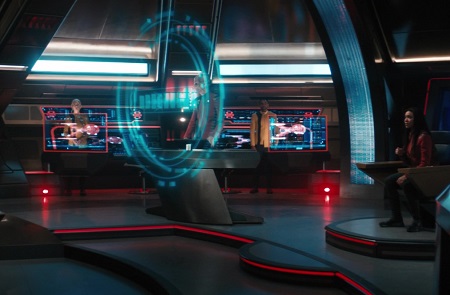
There is still an open question surrounding Zora’s burgeoning sentience, and what that could mean for Captain Burnham, the crew of Discovery, and indeed the rest of Starfleet. Whether this is something Season 4 will find time to tackle, or whether Zora will be dealt with in more detail on another occasion isn’t clear right now – but I think what is clear from what we heard in But To Connect is that Zora is firmly on Starfleet’s side.
Especially after Zora’s refusal to follow orders in Stormy Weather – a moment that came with a throwback to HAL 9000 from 2001: A Space Odyssey – I was somewhat nervously awaiting Zora going completely rogue, perhaps even doing something to endanger the ship and crew.
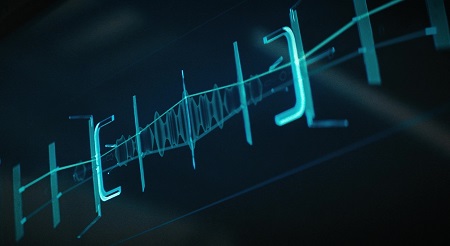
Though Zora’s refusal to share the co-ordinates of the DMA’s origin seemed, at first, to confirm my suspicion that this was the direction of travel for this storyline, Discovery ended up turning it around over the course of But To Connect, reassuring Zora that she could trust the crew of Discovery, and reassuring us as the audience that our heroes can trust her as well.
This was cemented by Zora sharing the co-ordinates of the DMA’s origin, but also by Zora being given an official role as a Starfleet mission specialist – the same loophole that brought Burnham aboard the ship after her mutiny in Season 1. Zora has started the process of becoming a more significant character on the show – something that I’d like to see continue in future episodes, as I kind of like the idea of the crew and ship working in tandem. It gives me Farscape vibes!
Retired theory #3:
Captain Burnham and the crew will encounter the Klingons.
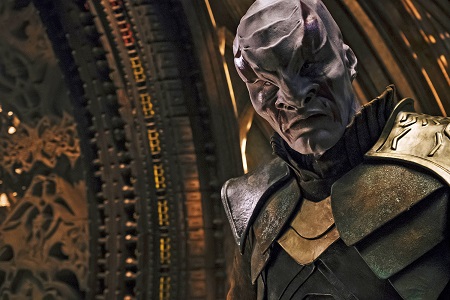
If we were going to see the Klingons this season, I think the diplomatic summit in But To Connect would have been where it happened. With the DMA seeming to be of extragalactic origin, it doesn’t seem like the Klingons will turn out to be the mysterious Unknown Species 10-C, either. So I’m choosing to retire this theory for now.
I don’t know why we haven’t seen any 32nd Century Klingons since Captain Burnham and the crew arrived last season. It’s possible that Discovery’s writers feel they’ve done all they can with the faction and want to move on to other stories, but having a Klingon or two as minor characters at key moments like the diplomatic summit wouldn’t get in the way of that. So I confess that I’m not sure why we haven’t seen any Klingons lately – but it doesn’t seem like we’re going to this season.
Confirmed theory:
Captain Burnham’s war experiences from Season 1 will come into play.

In But To Connect, we saw Captain Burnham arguing in favour of a less-aggressive posture toward the DMA. She drew on her own experiences with the Klingons, in part, to inform this decision. While Book and Tarka argued for attacking the DMA with their new weapon, Burnham was one of the key voices advocating for a peaceful stance and to try to make first contact with Unknown Species 10-C.
It’s reasonable to plan for worst-case scenarios, and as I argued in my review of But To Connect, the two contrasting approaches to the DMA didn’t have to be a zero-sum game. It would have been possible to take a more balanced position, as Discovery has tried to do all season long, in which the DMA-stopping weapon was built while the Federation also made an attempt at peaceful first contact. But regardless, I speculated last week that Burnham would be the one to argue for making an attempt at peaceful first contact, reminding everyone that no one currently knows what the DMA is supposed to be nor what the intentions of its creators were. And that’s pretty much what she did in But To Connect.
So those theories are done!
Now we’re going to jump into the main list, starting with a few new theories and a few theories that saw movement in But To Connect.
Theory #1:
Ruon Tarka’s mysterious “friend” is someone we’re already acquainted with.
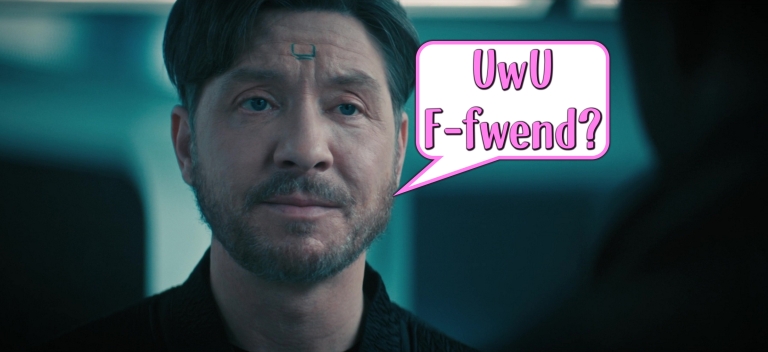
Why did Ruon Tarka avoid naming his “friend” when Book asked him about it? Tarka’s friend is supposedly one of the major motivating factors in him wanting to stop the DMA – he wants to use the power source at its centre to “punch through” to a parallel universe in the hopes of meeting up with this person. But when Book asked him who this individual was, Tarka tried to ignore the question.
This could be a complete over-reach, but I wonder if the reason for the secrecy is because Tarka’s friend is someone who we as the audience are already familiar with. This could be someone from Discovery, or it could be someone from a past iteration of Star Trek. Given that Tarka wants to travel to a parallel universe, perhaps his friend is the counterpart from that universe to someone we’re familiar with.
I put together a short list of possible candidates for being Tarka’s mysterious friend, and you can find it by clicking or tapping here.
Theory #2:
Tarka aims to travel to the Kelvin universe.
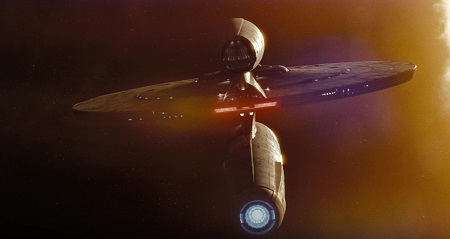
There are many parallel universes, as Tarka reminded us in But To Connect. The Mirror Universe is one that we’re familiar with from Discovery and from past iterations of Star Trek – but Tarka seemed to suggest that that isn’t his destination. In addition, Dr Kovich told us in Season 3 that travel to and from the Mirror Universe is no longer possible as of the 32nd Century.
Though Star Trek has shown us a number of different parallel universes before, the other major one that comes to mind is the Kelvin timeline (also known as the “JJ-verse”) in which the three reboot films were set. 2009’s Star Trek showed us the point of divergence; the moment at which this universe and the prime timeline separated: the arrival of Nero and his attack on the USS Kelvin. Star Trek Into Darkness and Star Trek Beyond furthered our understanding of that universe somewhat.
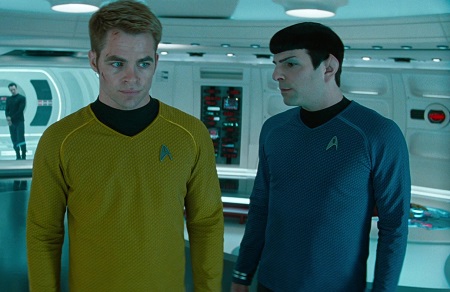
A fourth Kelvin film may or may not be happening, but even if it does the setting remains ripe for further exploration. We don’t know how far the Kelvin timeline and the prime timeline will have diverged, and whether it operates like the Mirror Universe with every character getting their own alternate counterpart. If it does, perhaps Tarka met his own Kelvin timeline counterpart and that’s how he cooked up this scheme.
Though Tarka is correct about the multitude of different universes and realities, of all the ones we’ve spent a significant amount of time with thus far in Star Trek, the Kelvin timeline seems the most likely destination. Compared to the likes of the Mirror Universe it’s safer, and if it diverged significantly from the prime timeline it stands to reason that the Burn never happened. We also got an oblique Kelvin timeline reference in Season 3 – could that have been a hint?
Theory #3:
Tarka’s friend made the DMA.

How does Ruon Tarka know so much about the DMA and its inner workings? It’s true that he got data from the USS Discovery’s mission, from the scans Book’s ship took, and from other sources, but even so he seems to have been able to figure out the precise mechanisms by which the DMA operates incredibly quickly. This leads me to suspect that he may know more about it than he’s willing to say.
We should acknowledge a production-side explanation here. The way Discovery Season 4 has been written and edited has seen a number of key moments in the DMA storyline blitzed through incredibly quickly. As the audience, we’ve been parachuted in just in time to see key moments: Stamets’ proto-wormhole theory, the DMA being an artificial construct, the DMA coming from outside of the galaxy, and the discovery of its origin point. The fact that these key moments happened in relatively short sequences with not a lot of setup adds to this sense that people like Tarka seem to have accumulated a lot of information about the DMA very quickly, and we should acknowledge that he claims to have been working on this problem off-screen for many weeks, if not months.

So there is that caveat. But something about the way Tarka stormed aboard the USS Discovery in The Examples with clear blueprints for building a scale model of the DMA did give me pause. And then in But To Connect, his plan to disable it (but not destroy it) using a very specific type of weapon also seems to have come along at a very convenient moment.
In short, I’m speculating that Tarka knows more about the DMA than he’s letting on, and that his friend may be involved in its creation. If his friend is from a parallel universe, they may have even built the DMA specifically to help Tarka travel there. In The Examples, Book accused Tarka of knowing who made the DMA, which could be a further piece of evidence.
Theory #4:
Book and Burnham will get back together.

If there’s one thing that I’d cut from Season 4 it would be the unnecessary insertion of more Burnham relationship drama. After everything she went through with Ash Tyler in Seasons 1 and 2, finding a way for her to feel settled was a huge net positive for the series. She doesn’t need to have that with Book, but having established that they worked very well together as a couple, undoing that would not be my preference.
So this is as much a hope as it is a bona fide theory, but I would like very much for Book and Burnham to resolve their differences – and quickly. Whether that will come from Book realising that Tarka has manipulated him, from Burnham reaching out, from the pair finding a way to compromise… it doesn’t really matter. But I’d hope that, within an episode or two of Season 4’s return, we can put all of this nonsense to bed. Permanently.
Theory #5:
The DMA isn’t a super-weapon.

We got a more detailed examination of this argument in But To Connect, and as mentioned it was Burnham – with no small amount of prompting from President Rillak – who led the charge.
In brief, the DMA being damaging and destructive doesn’t prove that it’s a super-weapon, even if it was artificially created. I’d add into this discussion the fact that the DMA, in all the weeks (or months) that it’s been in the Milky Way, has destroyed one planet and one small asteroid colony. If someone were using the DMA as a weapon, it seems remarkably inefficient to have harmed precisely two places in all that time.
Captain Burnham pointed out that we have no frame of reference when it comes to Unknown Species 10-C and the DMA. There’s simply no way of knowing what their intentions were by creating this anomaly, and while it could be a weapon, there’s also a chance that it isn’t. Right now, the fact that the DMA has been misunderstood feels like a distinct possibility.
Theory #6:
The DMA is a life-form.
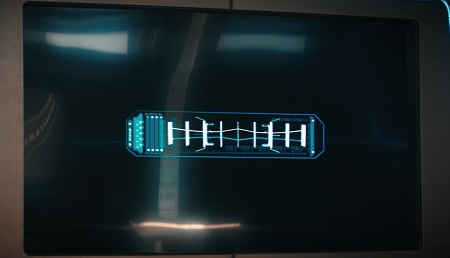
On the other side of But To Connect we got into a complex discussion with Stamets, Dr Kovich, and the others about the nature of Zora. At what point does an artificial construct become a distinct and unique life-form? This argument had echoes of past Star Trek episodes like The Measure of a Man and Author, Author, and was interesting in its own right. But could it be laying the groundwork for something to come with the DMA?
Star Trek has shown us life-forms like V’Ger – a giant energy cloud surrounding an artificial life-form. Perhaps the DMA is something similar, and while it may have started out as a simple piece of machinery, it has since evolved into something more. Just like with Zora, perhaps part of the second half of the season will be about understanding this new form of life – and protecting it, if necessary, from the likes of Tarka.
Theory #7:
Some areas of the galaxy – such as the Delta Quadrant – avoided the worst effects of the Burn.

In But To Connect, President Rillak told us that the diplomatic summit she convened would bring together races from “all four” quadrants. Assuming she was referring to the familiar Alpha, Beta, Gamma, and Delta Quadrants that make up the Milky Way galaxy, this would count as our first mention of the Delta Quadrant in the 32nd Century. I didn’t spot any familiar Delta Quadrant races (or their emblems) amongst the assembled delegates, however!
I had previously speculated that the Burn may not have affected the entire galaxy equally, and that regions farthest away from the Verubin Nebula may have survived without much damage. I still think that this is a possibility – though whether Discovery will revisit the Burn in any depth, or visit the Delta Quadrant at all, remains unclear.
To see a full write-up of this theory, click or tap here.
Theory #8:
There will be a character crossover from a past iteration of Star Trek.
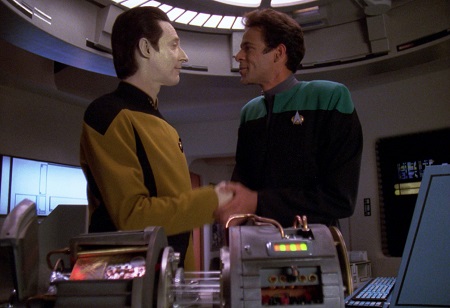
Ruon Tarka’s friend could, as mentioned, be someone we’ve already met. But there are other ways to bring back a character from a past iteration of the franchise – and there would be many potential benefits to doing so! I had initially proposed a version of this theory in the run-up to Season 3 that centred on the Doctor from Voyager – but with some creative technobabble, practically anyone could be included, despite the leap forward in time.
Choose To Live showed us the Abronians in cryo-sleep, and Stormy Weather saw the crew of Discovery use the transporter buffer to survive – just like Scotty had done in The Next Generation Season 6 episode Relics. Could these be hints at something to come?
It would also be possible for Captain Burnham to discover the logs or a holographic recording of a long-dead character – and while this would be less of a “crossover,” it could still be a ton of fun and great fan-service!
Theory #9:
President Rillak knows what the DMA is and may be responsible for its creation.

Although we’ve seen President Rillak working hard to unravel the DMA, I’m not ready yet to strike her (and the Federation) off my list of suspects! As we saw in But To Connect, President Rillak is very keen to see Earth (and other worlds) rejoin the Federation as quickly as possible. The DMA has facilitated greater contact between Earth and the Federation than there has been in a long time, and was also a driving force in Ni’Var rejoining. In short, if President Rillak ordered the DMA’s creation as part of a cunning plan to bring wayward ex-member worlds back into the fold… it’s working. At the very least, she isn’t letting the crisis go to waste!
I was also struck by President Rillak’s insistence on negotiating peacefully with Unknown Species 10-C. While this is perfectly in line with stated Federation values and objectives… could she have another motive? If the DMA was created by the Federation, destroying it could cause a shockwave to resonate along its wormhole and damage or even destroy the Federation facility or planet where the DMA was originally created. President Rillak’s peaceful approach may be intended to protect the people who created it – because she knows who that is.

Despite her recent appearances seeming to suggest she’s firmly on Captain Burnham’s side, I see a noticeable manipulative, almost Machiavellian side to President Rillak. She’s brought Burnham on board because she believes working together is to her advantage, as she did with the Ni’Var negotiations and at the diplomatic summit. But she also used Burnham in both of those cases to advocate positions that it would be politically or diplomatically difficult for her to do openly – effectively manipulating those events from behind the scenes.
Captain Burnham needs to tread very carefully, as I firmly believe that President Rillak is someone who will happily throw her – and everyone aboard the USS Discovery – under the bus in a heartbeat if she believed doing so would advance what she considers to be the Federation’s best interests. And if she believed that the way to bring the Federation back together is to give the various independent worlds a threat that they couldn’t handle alone… well, that might just be the reason why she sought to create something like the DMA.
As stated in previous weeks, President Rillak may not have created the DMA, nor ordered its creation, but may be covering it up because it’s in the Federation’s best interests in her opinion. She may also be choosing to keep this knowledge hidden so she can continue to exploit the DMA for her own purposes.
Theory #10:
Season 4 will connect with the Short Treks episode Calypso.
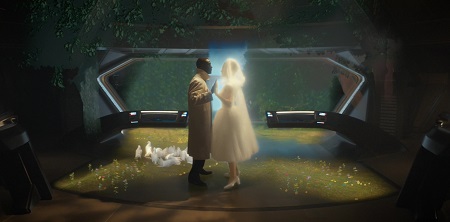
Zora’s status as a member of the crew was confirmed in But To Connect, and this followed her developing emotions and sentience earlier in the season. Zora is now much closer to her presentation in Calypso, potentially bringing the story of the Short Treks episode one step closer.
There are still significant hurdles to overcome if the story of Calypso is to be wrapped up in Season 4, though. Obviously we have the timeframe issue: will the USS Discovery be sent back in time, be abandoned, or is Calypso taking place centuries in the future? Then we have the USS Discovery itself – it’s been retrofitted since arriving in the 32nd Century, and now looks very different to how it did in Calypso. I’m not sure how Discovery will overcome these hurdles – but it’s possible. It feels like a proper link-up with Calypso is edging closer week by week.
So those theories are new or saw movement last week.
Now, as always, I’ll keep the theory list all in one place by recapping all of the other theories that I currently have in play for Discovery Season 4.
Theory #11:
Unknown Species 10-C is a faction from a past iteration of Star Trek.

Despite the fact that the DMA has passed through the galactic barrier, making assumptions is dangerous! We’re only at the season’s halfway point, after all, so there’s plenty of time for twists and turns.
Based on the DMA potentially having an origin outside of the Milky Way, the three suspects that immediately spring to mind are the Kelvan Empire, the Sphere-Builders, and the super-synths from Season 1 of Star Trek: Picard. They’d all been on my list of suspects going back months, and I really feel that any one of them would make for a potentially interesting story.
I have a longer list of suspects for Unknown Species 10-C, so for a more detailed look at these three candidates – and many others – click or tap here to see the full list.
Theory #12:
A major character will be killed off.

Lieutenant Tilly’s departure in All Is Possible definitely shook up the cast. And Gray’s departure in But To Connect may do so as well. However, I stand by what I said before the season aired: killing off a character can be a great way to demonstrate the dangerous nature of the circumstances that the crew have found themselves in. So far, despite tangling with the DMA on several occasions, only a couple of redshirts have lost their lives.
In Stormy Weather, Dr Pollard raced through the corridors of the USS Discovery to reach a hull breach. Shortly after she arrived, a redshirt was blown out into space – but Dr Pollard survived. Although moments like this can make it feel that Discovery is shielding its main and secondary characters with some pretty heavy plot armour, I still feel that there’s scope to see a major character death before the season ends.
If you want to check out my pre-season “death predictions,” in which I speculated about which characters may or may not be in danger, you can find that by clicking or tapping here.
Theory #13:
The Guardian of Forever will be back.
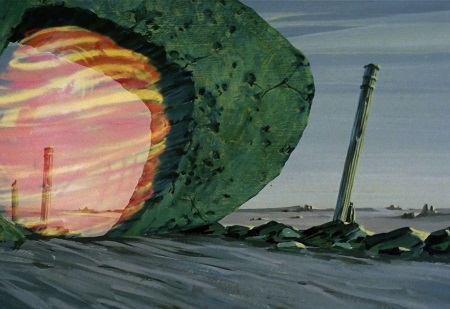
Having reintroduced the Guardian of Forever in Season 3, I wouldn’t be at all surprised to see Discovery return to the Guardian’s planet in Season 4. Because Captain Burnham and the crew still don’t know much about the DMA or Unknown Species 10-C, it would make sense to at least ask the Guardian for help – maybe it has encountered this phenomenon or the people who made it before.
The Guardian of Forever is also the only way we know of at present to travel through time – something that might be necessary if Season 4 makes an attempt to link up with Calypso in a big way. There are many reasons why Captain Burnham might want to revisit the Guardian, and it would be great to bring back actor Paul Guilfoyle, who played the Guardian’s humanoid avatar in Season 3.
Theory #14:
The crew will have to defend the Verubin Nebula.
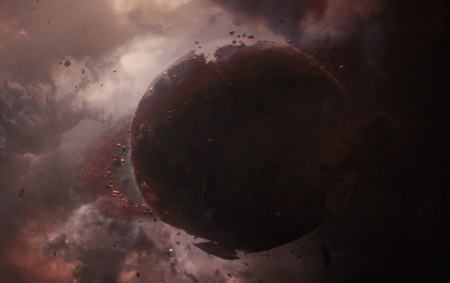
Despite having grown to sixty member worlds, the Federation is still in a weakened state and isn’t yet back to full strength. The Verubin Nebula is thus a very tempting target for anyone looking to gain an edge in a galaxy where dilithium is still in short supply. As the only known significant cache of the valuable fuel, whoever controls the Verubin Nebula will have a massive tactical advantage.
It would begin to stretch credulity to think that everyone in the known galaxy would see the Federation rebuilding and having access to dilithium and not want to find out for themselves what’s going on. Once the Verubin Nebula’s existence becomes known, even if the Federation promises to share its bounty with all comers, it seems very likely that someone would want to take control of the dilithium supply for themselves. This could even be the objective Unknown Species 10-C have – they may be looking for a way to control the Verubin Nebula and its supply of dilithium.
Theory #15:
The ban on time travel will be explained in more detail.

This one is as much a hope as a theory right now! In short, the ban on time travel was introduced early in Season 3 primarily as a way for the writers and producers to avoid questions about why the 32nd Century was so different from how the far future had been depicted in earlier Star Trek productions, as well as to explain things like how the Burn was able to catch the Federation off-guard and why Georgiou couldn’t simply be sent back in time when she needed to.
But the ban itself raises some issues – the biggest one being the lack of detail on how it works and how something like this could possibly be enforced. As I said several times last season, it isn’t possible to just un-invent a technology so useful and powerful as time travel. Even just a few lines of dialogue going into a little more detail on the mechanisms involved in the ban would be really useful.
Theory #16:
The Federation has flouted the ban on time travel.
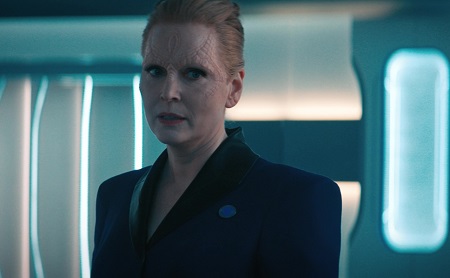
Sticking with the time travel ban, another theory I had last season was that the Federation – and Section 31 in particular – might have deliberately flouted the ban and failed to abide by the rules. Someone as straight-laced and committed to Starfleet ideals as Admiral Vance is highly unlikely to have sanctioned such a move, but there are other Federation leaders – such as President Rillak – who could be implicated.
Obviously the bulk of the season’s story will deal with the DMA. But there’s scope to either talk about the time travel ban in a standalone episode or even tie the two stories together – perhaps the anomaly has been unleashed as a result of unsanctioned time travel.
Theory #17:
Michael Burnham won’t remain captain of Discovery.
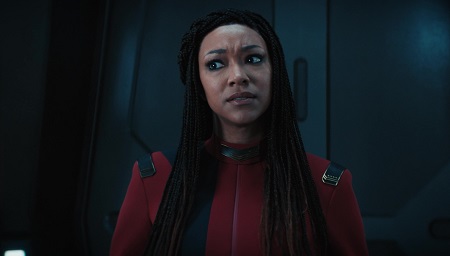
This is a controversial one, so let me just say up front that I’m neither in favour of this theory nor opposed to it – I just think it’s a possibility. As things stand, Discovery has had four different captains across its four seasons. One of the show’s unique points of interest within Star Trek’s broader canon are the very different ways in which these individual captains commanded the ship and crew.
It’s got to be considered a possibility, then, that the show will continue this trend. This doesn’t mean Captain Burnham will be killed off; I’d actually argue she’s pretty safe. But there are many different routes to her potentially leaving the ship, such as a desire for freedom that we saw in Season 3, or even perhaps taking up a new, more senior role within Starfleet.
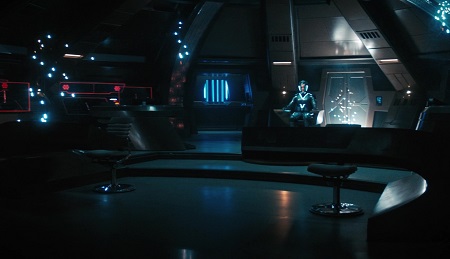
If this theory were to come to pass, it would be something I’d expect to see at the very end of the season. Even if Burnham seems 100% committed to her new role as captain, I don’t think it’s a theory we can definitively rule out.
It’s worth mentioning that at time of writing Discovery hasn’t been officially renewed for a fifth season – so all this talk of who’ll be in the captain’s chair by then could be moot! And of course this theory has a very strong counter-argument: that Discovery’s main story arc across its first three seasons can be read as Burnham’s ascent to the captain’s chair.
Theory #18:
Saru will be given the captaincy of the USS Voyager-J.

Saru’s future was briefly discussed before he offered to serve as Captain Burnham’s first officer in the episode Anomaly. He has already been offered a command of his own, so Starfleet clearly values his command abilities and experience. President Rillak was seen to be assessing Captain Burnham’s suitability for the captaincy of the USS Voyager-J in Kobayashi Maru… and she mentioned having a shortlist of candidates. Could Saru be on her list?
Several of the qualities that President Rillak said she was looking for in a potential captain seem to apply to Saru. He’s more level-headed, less likely to put himself in a dangerous situation, and more inclined to think of the big picture. He has a weakness when it comes to Kaminar, as we saw toward the end of Season 3, but generally speaking he isn’t someone who lets his emotions get the better of him. His wisdom and calm demeanour could be valuable in the captain’s chair of the Federation flagship. This could also set the stage for his departure from the show, or possibly even for a new show following his adventures aboard his new ship.
Theory #19:
Book will find Kyheem and Leto inside the DMA.
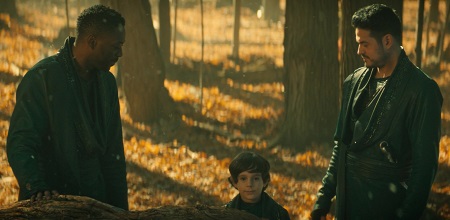
In Star Trek: Generations, Captain Picard encountered Captain Kirk inside the Nexus – despite Kirk being declared “dead” after the Enterprise-B encountered the energy ribbon almost eighty years earlier. The DMA’s similarly mysterious nature raises the faint possibility that at least some of those it appears to have “killed” may not be as dead as they first appear.
This theory is, I freely admit, a bit of a long-shot. And it hinges on a fundamental question underlying the story of the season: what’s going on with the DMA? Was it designed to kill? Or is it some kind of method of faster-than-light travel, using the wormhole at its core? If it’s the latter, perhaps some of the people on Kwejian may have survived or been transported to wherever Unknown Species 10-C reside.
Theory #20:
We haven’t seen the last of the Abronians.
I currently have four ideas for different ways that the Abronians – the non-humanoid race that Captain Burnham, Tilly, and the Qowat Milat helped save from cryo-sleep in the episode Choose To Live – could play a further role in Season 4.
Theory #20a:
The Abronians’ homeworld was destroyed by the DMA.
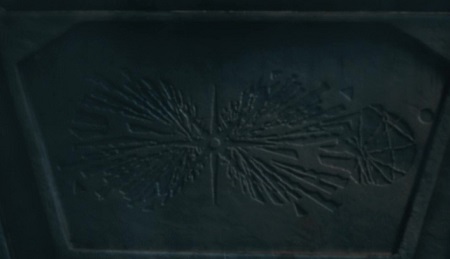
After arriving at the Abronians’ cryo-ship, Captain Burnham found a stone carving that seemed to depict the destruction of the Abronians’ homeworld. This carving was only shown on screen briefly, but it seemed to show the planet being damaged or destroyed in a large explosion. Burnham credited the planet’s destruction to a “supernova,” and the story then raced ahead.
Considering that the main thrust of the season so far has been about the DMA, perhaps Burnham was incorrect: the Abronian homeworld was destroyed by the anomaly, not a supernova.
Theory 20b:
The Abronians’ homeworld was on the “other side” of the DMA.

The DMA seemingly contains the technology to generate an artificial wormhole. It’s thus possible that the DMA can facilitate travel between incredibly distant locations – not only for itself, but for other starships too. The subspace tear that the DMA left behind went nowhere – but it may be possible to get “inside” the DMA itself or even use its wormhole tech to travel vast distances.
One thing struck me as odd about the Abronians: the Federation was entirely unaware of them, despite the Abronian cryo-ship being relatively close to Federation space – such that Captain Burnham could reach it using Book’s ship in a short span of time. It’s possible that the Abronians had been asleep for millennia, unnoticed by the Federation and the wider galaxy for all that time. But it’s also at least possible that their cryo-ship is a newcomer to the area. If so, perhaps it arrived here via the DMA.
Theory #20c:
The Abronians will return to help the Federation later in the season.
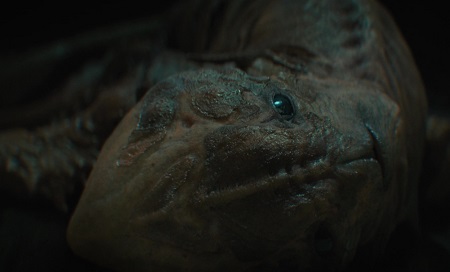
One of the themes of Discovery since Season 3 has been connection, including building connections between the Federation and other races and organisations. The Abronians were awoken from cryo-sleep thanks to the interventions of Captain Burnham and Tilly – at least in part – and they may seek to repay the Federation, or Captain Burnham personally, for that help.
We saw this play out last season with Ni’Var; in the season finale Ni’Var ships raced to the Federation’s aid as the Emerald Chain attacked. Perhaps the Abronians will likewise step up to help when the Federation needs allies.
Theory #20d:
The Abronians’ moon-ship may be useful in a later story.

The Abronians’ cryo-ship is huge, and at least superficially seems to have the mass of a moon or small planetoid. If Captain Burnham and the crew needed a starship that large, such as to aid in the evacuation of a planet threatened by the DMA, for example, perhaps they’ll return to the Abronians and ask to borrow it.
As we saw in Choose To Live, the moon-ship was in full working order. All it needed was some extra dilithium to power up and it was perfectly capable of moving under its own power, and its computer systems were still functional. The only system that seemed to have failed was the wake-up timer! So if the crew are in need of a huge starship, perhaps we won’t have seen the last of the moon-ship!
Theory #21:
Captain Burnham and/or the Red Angel suits from Season 2 are connected to the DMA.
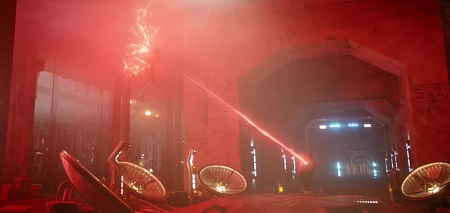
Now that we know the DMA is artificial in nature, the question shifts to who built it and why. We’ve covered the idea of it being a weapon or an out-of-control experiment, as well as being a life-form in its own right. It could also be something created by the Federation. But because this is Star Trek: Discovery, a show which likes to put Captain Burnham at the centre of its stories, perhaps there’s a connection to her that we’re missing.
The Red Angel time travel suits from Season 2 were phenomenally powerful machines, capable of generating time-wormholes large enough to transport an entire starship 930 years into the future. We already know that the DMA potentially contains a synthetic wormhole, so it wouldn’t be a huge leap to connect the two. We also don’t know for certain what became of Captain Burnham’s Red Angel suit after the Season 3 premiere. There’s also the faint possibility of a parallel universe Burnham or time travelling Burnham being responsible.
Theory #22:
Ruon Tarka – perhaps aided by Book or Stamets – will create the DMA.
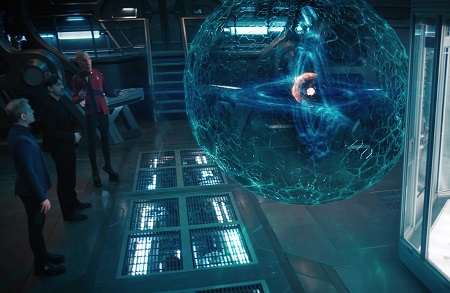
I included Tarka on my list of suspects for the creators of the DMA, but this warrants a full entry on the theory list too! In short, we saw Stamets and Ruon Tarka creating a scale model of the DMA in The Examples, and according to Reno their experiment came very close to destroying the entire ship. They were able to perfectly recreate the device at the centre of the DMA, albeit on a smaller scale – so what’s to prevent Tarka from building a full-scale replica (other than the power generation requirements)?
This theory posits that he will do exactly that – somehow – or that his experiments will set into motion a chain of events that leads to the creation of the DMA in a kind of time-loop storyline. The DMA’s wormhole-generating technology may give it the ability to travel backwards through time as well as across vast distances, so it seems technologically plausible at the very least.

But To Connect fleshed out Tarka a little more, giving backstory to him and a potential motive for his single-minded pursuit of the DMA. He also may know more about the anomaly than he’s letting on – including who is responsible for its creation. Regardless, Tarka has been shown as someone willing to take all kinds of risks, and it’s not impossible to think that one of his risks could backfire – creating the DMA in the process.
Personally, I find time-loop paradox storylines to be frustrating – and they can be very difficult to pull off successfully. There’s no beginning point to such a story: the DMA exists because the DMA was created because the DMA exists because the DMA was created… it’s an infinite loop. But we’ve seen Discovery tackle time travel stories like this before – and the pieces seem to be in play right now for this theory to pan out.
So that’s the main theory list.
We also have two production-side theories in play, and I’ll recap those now.
Production-side theory #1:
Tilly’s departure will be permanent.

Mary Wiseman confirmed in an interview with Wil Wheaton on The Ready Room (Discovery’s social media aftershow) that Tilly will be seen again before the end of Season 4, and we glimpsed her in the trailer for the second half of the season as well. But that doesn’t mean she will return as a main character on the show going forward, and her departure in All Is Possible felt permanent. Despite that, I’ve seen quite a lot of folks online who don’t believe that Tilly is actually leaving the series – so I wanted to put it out there officially and say that, in my opinion anyway, she is.
Maybe those people know something that I don’t! As I always say, I don’t have any “insider information;” all of this is just speculation on my part. However, I feel that the manner of Tilly’s departure, the fact that she got that emotional sequence with Captain Burnham, a montage showing her leaving the ship, Adira seeming to take over several of her roles, and her departure feeling like the culmination of her arc going back to the latter part of Season 3 all come together to strongly indicate that she won’t be back as a major character. She may yet have a significant role to play in a future Season 4 episode, as has been suggested, but unless Discovery’s writers are really playing with our emotions I believe we’ve seen Tilly’s end as a main character on the show. She may come back in a future Starfleet Academy series, though… so watch this space!
Production-side theory #2:
Star Trek: Discovery isn’t going to be renewed for Season 5.
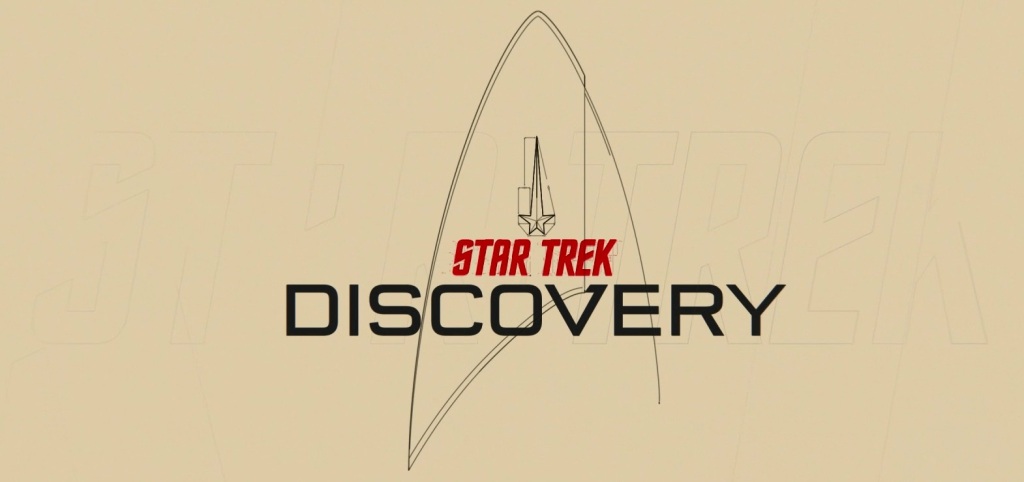
Since Discovery debuted in 2017, we’ve known well before this point in the season that the show has been renewed. This obviously isn’t one of those “I hate new Star Trek” things that we’ve seen doing the rounds online for years; I adore Discovery and genuinely want to see it continue. But it’s profoundly odd to have arrived at Season 4’s mid-season break and to still have had no announcement about Season 5. For comparison, Star Trek: Picard has been renewed for Season 3 even though Season 2 hasn’t aired yet.
I’m hopeful that this is just a blip; a temporary delay for reasons unknown, and that the show has been renewed for Season 5 already behind the scenes. However, when we look back at Star Trek productions in recent years, it was often apparent that production work was quietly ongoing even if there hadn’t been any official word from ViacomCBS. As far as we know at this stage, there’s been no pre-production work on Season 5, let alone any filming taking place in the Toronto area. The abrupt announcement that the show is taking a mid-season break could also be indicative of issues with the production.
Once again, this is a “watch this space” kind of theory. I hope I’m wrong… but the lack of any news or even any significant rumours about the show’s future is beginning to have me worried.
So that’s it.

We’ve hit the halfway point of Season 4 with a number of theories still in play! There are major questions surrounding Ruon Tarka, Cleveland Booker, the nature of the DMA, and Unknown Species 10-C in particular that all need answers when the show returns next month. It’s going to feel like a long wait!
Before we go, one final point. I write up these theories because I like Star Trek and I like writing. But for some folks, fan theories can hamper their enjoyment of a film or television show. It’s worth keeping in mind that most of these theories probably won’t pan out, and we have to be prepared for the fact that even the most well-constructed fan theory, no matter how fun and plausible it seems, simply won’t turn out to be true. If you find that speculating and reading theories is beginning to detract from your enjoyment of Star Trek: Discovery – or any other television show or film – it might be a good idea to take a break for a while.
Star Trek: Discovery Season 4 is currently on hiatus and will return on the 10th of February. The first half of Season 4 is available to stream now on Paramount+ in the United States, Scandinavia, Latin America, and Australia. The show is on Pluto TV in the UK, France, Germany, Italy, and other parts of Western Europe at 9pm on Fridays and Saturdays. Individual episodes or the full season can be purchased on iTunes, Amazon Video, YouTube, and possibly other platforms in the UK, parts of Europe, and select other countries. The Star Trek franchise – including Discovery and all other properties mentioned above – is the copyright of ViacomCBS. This article contains the thoughts and opinions of one person only and is not intended to cause any offence.




